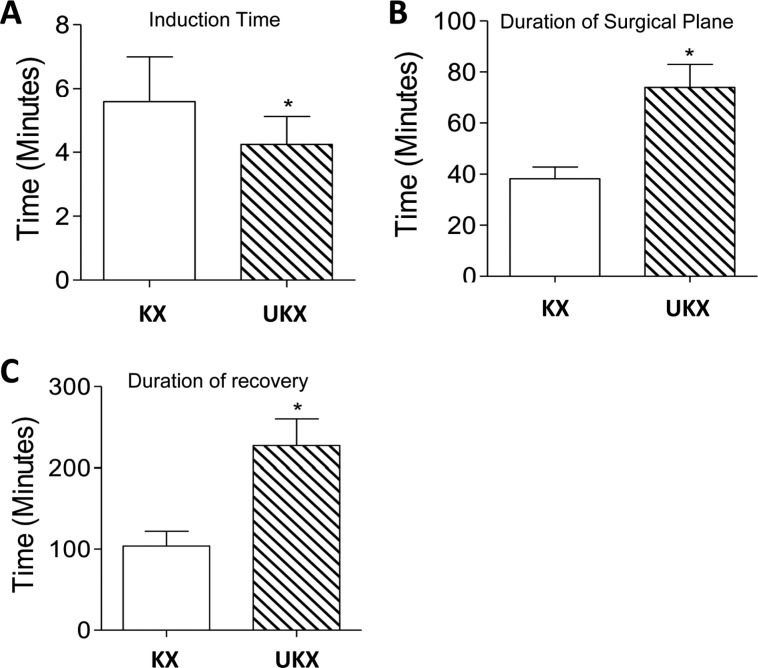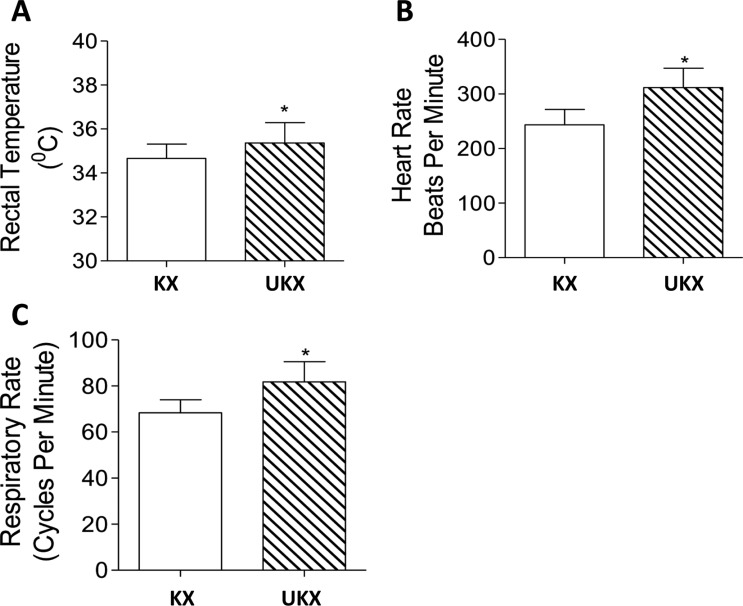Lab Anim Res.
2015 Dec;31(4):174-179. 10.5625/lar.2015.31.4.174.
Intraperitoneal co-administration of low dose urethane with xylazine and ketamine for extended duration of surgical anesthesia in rats
- Affiliations
-
- 1School of Veterinary Medicine, University College Dublin, Belfield, Dublin-04, Ireland. arun.kumar@ucd.ie
- 2Department of Plastic Surgery, University College Cork, Cork, Ireland; Centre for Research in Vascular Biology, University College Cork, Cork, Ireland.
- KMID: 2312143
- DOI: http://doi.org/10.5625/lar.2015.31.4.174
Abstract
- Procedures involving complex surgical techniques in rats, such as placement of abdominal aortic graft require extended duration of surgical anesthesia, which often can be achieved by repeated administrations of xylazine-ketamine combination. However such repeated anesthetic administration, in addition to being technically challenging, may be associated with potential adverse events due to cumulative effects of anesthesia. We report here the feasibility of using urethane at low dose (~1/10 the recommended anesthetic dose) in combination with a xylazine-ketamine mix to achieve an extended duration of surgical anesthesia in rats. The anesthesia induction phase was quick and smooth with an optimal phase of surgical anesthesia achieved for up to 90 minutes, which was significantly higher compared to that achieved with use of only xylazine-ketamine combination. The rectal temperature, heart rate and respiratory rate were within the physiological range with an uneventful recovery phase. Post surgery the rats were followed up to 3 months without any evidence of tumor or any other adverse effects related to the use of the urethane anesthetic combination. We conclude that low dose urethane can be effectively used in combination with xylazine and ketamine to achieve extended duration of surgical anesthesia up to 90 minutes in rats.
Keyword
MeSH Terms
Figure
Reference
-
1. Arun KH, Kaul CL, Ramarao P. AT1 receptors and L-type calcium channels: functional coupling in supersensitivity to angiotensin II in diabetic rats. Cardiovasc Res. 2005; 65(2):374–386. PMID: 15639476.2. Arun KH, Kaul CL, Poduri R. Tempol augments angiotensin IIinduced AT2 receptor-mediated relaxation in diabetic rat thoracic aorta. J Hypertens. 2004; 22(11):2143–2152. PMID: 15480099.
Article3. Piche M, Watanabe N, Hotta H. Regulation of gastric motility and blood flow during acute nociceptive stimulation of the paraspinal muscles in urethane-anaesthetised rats. J Physiol Sci. 2014; 64(1):37–46. PMID: 24037728.
Article4. Habara H, Hayashi Y, Inomata N, Niijima A, Kangawa K. Organspecific activation of the gastric branch of the efferent vagus nerve by ghrelin in urethane-anesthetized rats. J Pharmacol Sci. 2014; 124(1):31–39. PMID: 24366191.
Article5. Tran RT, Choy WM, Cao H, Qattan I, Chiao JC, Ip WY, Yeung KW, Yang J. Fabrication and characterization of biomimetic multichanneled crosslinked-urethane-doped polyester tissue engineered nerve guides. J Biomed Mater Res A. 2014; 102(8):2793–2804. PMID: 24115502.
Article6. Krynauw H, Bruchmuller L, Bezuidenhout D, Zilla P, Franz T. Degradation-induced changes of mechanical properties of an electro-spun polyester-urethane scaffold for soft tissue regeneration. J Biomed Mater Res B Appl Biomater. 2011; 99(2):359–368. PMID: 21948379.
Article7. Chiono V, Sartori S, Rechichi A, Tonda-Turo C, Vozzi G, Vozzi F, D'Acunto M, Salvadori C, Dini F, Barsotti G, Carlucci F, Burchielli S, Nicolino S, Audisio C, Perroteau I, Giusti P, Ciardelli G. Poly(ester urethane) guides for peripheral nerve regeneration. Macromol Biosci. 2011; 11(2):245–256. PMID: 21104881.
Article8. Kumar AH, Martin K, Turner EC, Buneker CK, Dorgham K, Deterre P, Caplice NM. Role of CX3CR1 receptor in monocyte/macrophage driven neovascularization. PLoS One. 2013; 8(2):e57230. PMID: 23437346.
Article9. Clover AJ, Kumar AH, Caplice NM. Deficiency of CX3CR1 delays burn wound healing and is associated with reduced myeloid cell recruitment and decreased sub-dermal angiogenesis. Burns. 2011; 37(8):1386–1393. PMID: 21924836.
Article10. Shen Z, Chen J, Kang C, Gong C, Zhu Y. Engineered hypopharynx from coculture of epithelial cells and fibroblasts using poly(ester urethane) as substratum. Biomed Res Int. 2013; 2013:138504. PMID: 24455669.
Article11. Hong Y, Guan J, Fujimoto KL, Hashizume R, Pelinescu AL, Wagner WR. Tailoring the degradation kinetics of poly(ester carbonate urethane)urea thermoplastic elastomers for tissue engineering scaffolds. Biomaterials. 2010; 31(15):4249–4258. PMID: 20188411.
Article12. Boissard CI, Bourban PE, Tami AE, Alini M, Eglin D. Nanohydroxyapatite/poly(ester urethane) scaffold for bone tissue engineering. Acta Biomater. 2009; 5(9):3316–3327. PMID: 19442765.
Article13. Field JR, Gunatillake P, Adhikari R, Ramshaw JA, Werkmeister JA. Use of biodegradable urethane-based adhesives to appose meniscal defect edges in an ovine model: a preliminary study. Aust Vet J. 2008; 86(6):229–234. PMID: 18498559.
Article14. Furtado KS, Andrade FO. Comparison of the beneficial and adverse effects of inhaled and injectable anaesthetics: A minireview. OA Anaesthetics. 2013; 1(2):20.
Article15. Zou X, Liu F, Zhang X, Patterson TA, Callicott R, Liu S, Hanig JP, Paule MG, Slikker W Jr, Wang C. Inhalation anesthetic-induced neuronal damage in the developing rhesus monkey. Neurotoxicol Teratol. 2011; 33(5):592–597. PMID: 21708249.
Article16. Agostoni M, Fanti L, Gemma M, Pasculli N, Beretta L, Testoni PA. Adverse events during monitored anesthesia care for GI endoscopy: an 8-year experience. Gastrointest Endosc. 2011; 74(2):266–275. PMID: 21704990.
Article17. Sneyd JR, Holmes KA. Inhalational or total intravenous anaesthesia: is total intravenous anaesthesia useful and are there economic benefits? Curr Opin Anaesthesiol. 2011; 24(2):182–187. PMID: 21252648.
Article18. Ritschl LM, Fichter AM, Haberle S, von Bomhard A, Mitchell DA, Wolff KD, Mucke T. Ketamine-Xylazine Anesthesia in Rats: Intraperitoneal versus Intravenous Administration Using a Microsurgical Femoral Vein Access. J Reconstr Microsurg. 2015; 31(5):343–347. PMID: 25702886.
Article19. Giroux MC, Helie P, Burns P, Vachon P. Anesthetic and pathological changes following high doses of ketamine and xylazine in Sprague Dawley rats. Exp Anim. 2015; 64(3):253–260. PMID: 25818316.
Article20. Albrecht M, Henke J, Tacke S, Markert M, Guth B. Effects of isoflurane, ketamine-xylazine and a combination of medetomidine, midazolam and fentanyl on physiological variables continuously measured by telemetry in Wistar rats. BMC Vet Res. 2015; 10:198. PMID: 25149627.
Article21. Dittmar MS, Fehm NP, Vatankhah B, Horn M. Ketamine/xylazine anesthesia for radiologic imaging of neurologically impaired rats: dose response, respiratory depression, and management of complications. Comp Med. 2004; 54(6):652–655. PMID: 15679263.22. Wanger T, Takagaki K, Lippert MT, Goldschmidt J, Ohl FW. Wave propagation of cortical population activity under urethane anesthesia is state dependent. BMC Neurosci. 2013; 14:78. PMID: 23902414.
Article23. Wang K, Zhu H, Chen CY, Li P, Jin CH, Wang ZL, Jiang S, Hua TM. [Effects of ketamine and urethane on stimulation-induced cfos expression in neurons of cat visual cortex]. Dongwuxue Yanjiu. 2013; 34(6):582–588. PMID: 24415690.24. Aizawa N, Ogawa S, Sugiyama R, Homma Y, Igawa Y. Influence of urethane-anesthesia on the effect of resiniferatoxin treatment on bladder function in rats with spinal cord injury. Neurourol Urodyn. 2015; 34(3):274–279. PMID: 24375785.
Article25. Liu X, Li R, Yang Z, Hudetz AG, Li SJ. Differential effect of isoflurane, medetomidine, and urethane on BOLD responses to acute levo-tetrahydropalmatine in the rat. Magn Reson Med. 2012; 68(2):552–559. PMID: 22213080.
Article26. Smith PP, Kuchel GA. Continuous uroflow cystometry in the urethane-anesthetized mouse. Neurourol Urodyn. 2010; 29(7):1344–1349. PMID: 20127833.
Article27. Sharma AV, Wolansky T, Dickson CT. A comparison of sleeplike slow oscillations in the hippocampus under ketamine and urethane anesthesia. J Neurophysiol. 2010; 104(2):932–939. PMID: 20538775.
Article28. Bertera FM, Di Verniero CA, Mayer MA, Bramuglia GF, Taira CA, Höcht C. Is urethane-chloralose anaesthesia appropriate for pharmacokinetic-pharmacodynamic assessment? Studies with carvedilol. J Pharmacol Toxicol Methods. 2009; 59(1):13–20. PMID: 18973819.
Article29. Princi T, Delbello G, Grill V. Experimental urethane anaesthesia prevents digoxin intoxication: electrocardiographic and histological study in rabbit. Pharmacol Res. 2000; 42(4):355–359. PMID: 10987996.
Article30. el-Mas MM, Abdel-Rahman AA. Contrasting effects of urethane, ketamine, and thiopental anesthesia on ethanol-clonidine hemodynamic interaction. Alcohol Clin Exp Res. 1997; 21(1):19–27. PMID: 9046368.
Article31. Gonsenhauser I, Wilson CG, Han F, Strohl KP, Dick TE. Strain differences in murine ventilatory behavior persist after urethane anesthesia. J Appl Physiol. 1985; 97(3):888–894. PMID: 15333626.
Article32. El Desoky ES, Abdulla MM. Studying long-term effect of phenytoin either alone or combined with ascorbic acid on the anesthetic effect of urethane in rats. Fundam Clin Pharmacol. 2004; 18(2):153–156. PMID: 15066128.
Article33. Zorniak M, Mitrega K, Bialka S, Porc M, Krzeminski TF. Comparison of thiopental, urethane, and pentobarbital in the study of experimental cardiology in rats in vivo. J Cardiovasc Pharmacol. 2010; 56(1):38–44. PMID: 20351562.34. Clement EA, Richard A, Thwaites M, Ailon J, Peters S, Dickson CT. Cyclic and sleep-like spontaneous alternations of brain state under urethane anaesthesia. PLoS One. 2008; 3(4):e2004. PMID: 18414674.
Article35. Devonshire IM, Grandy TH, Dommett EJ, Greenfield SA. Effects of urethane anaesthesia on sensory processing in the rat barrel cortex revealed by combined optical imaging and electrophysiology. Eur J Neurosci. 2010; 32(5):786–797. PMID: 20646050.
Article36. Bauquier SH, Golder FJ. The effects of urethane on the isoflurane minimum alveolar concentration in rats. Lab Anim. 2010; 44(4):323–328. PMID: 20713428.
Article37. Blatt LK, Lashinger ES, Laping NJ, Su X. Evaluation of pressor and visceromotor reflex responses to bladder distension in urethane anesthetized rats. Neurourol Urodyn. 2009; 28(5):442–446. PMID: 19030181.
Article38. Albrecht D, Blühdorn R, Siegmund H, Berger H, Calo' G. Inhibitory action of nociceptin/orphanin FQ on functionally different thalamic neurons in urethane-anaesthetized rats. Br J Pharmacol. 2001; 134(2):333–342. PMID: 11564651.
Article39. Soehring K, Frahm M. [Pharmacology of alkylpolyethylene oxide derivatives. VII. Effect on circulation and respiration in cats under urethane and evipan sodium narcosis in comparison with other local analgesics]. Arzneimittelforschung. 1955; 5(11):655–662. PMID: 13293062.40. Duenas-García IE, Santos-Cruz LF, Castaneda-Partida L, Castaneda-Sortibran AN, Ordaz-Tellez MG, Sanchez-Santos A, Duran-Díaz A, Rodríguez-Arnaiz R, Heres-Pulido ME. Interactions of sulforaphane and dimethyl sulfoxide with methyl methanesulfonate, urethane, 4-nitroquinoline-1-oxide and hydrogen peroxide in the Drosophila melanogaster wing spot test. Food Chem Toxicol. 2012; 50(12):4479–4486. PMID: 23026699.41. Beland FA, Benson RW, Mellick PW, Kovatch RM, Roberts DW, Fang JL, Doerge DR. Effect of ethanol on the tumorigenicity of urethane (ethyl carbamate) in B6C3F1 mice. Food Chem Toxicol. 2005; 43(1):1–19. PMID: 15582191.
Article42. Sakano K, Oikawa S, Hiraku Y, Kawanishi S. Metabolism of carcinogenic urethane to nitric oxide is involved in oxidative DNA damage. Free Radic Biol Med. 2002; 33(5):703–714. PMID: 12208357.
Article43. Chan PC. NTP technical report on toxicity studies of urethane in drinking water and urethane in 5% ethanol administered to F344/N rats and B6C3F1 mice. Toxic Rep Ser. 1996; 52:1–91. PMID: 11803705.44. Vorobtsova IE, Kitaev EM. Urethane-induced lung adenomas in the first-generation progeny of irradiated male mice. Carcinogenesis. 1988; 9(11):1931–1934. PMID: 3180332.
Article45. Ward JM, Rehm S, Devor D, Hennings H, Wenk ML. Differential carcinogenic effects of intraperitoneal initiation with 7,12-dimethylbenz(a)anthracene or urethane and topical promotion with 12-O-tetradecanoylphorbol-13-acetate in skin and internal tissues of female SENCAR and BALB/c mice. Environ Health Perspect. 1986; 68:61–68. PMID: 3096710.
Article
- Full Text Links
- Actions
-
Cited
- CITED
-
- Close
- Share
- Similar articles
-
- Effects of Pentobarbital Sodium, Ketamine and Xylazine on Learning Impairment Induced by Transient Global Ischemia in Mongolian Gerbils
- Aged mice show an increased mortality after anesthesia with a standard dose of ketamine/xylazine
- Gender differences in paclitaxel-induced neuropathic pain behavior and analgesic response in rats
- The Effect of Brimonidine Premedication on the Sympathetic Nervous System during Ketamine Anesthesia in the Ratv
- Effect of intratesticular injection of xylazine/ketamine combination on canine castration



